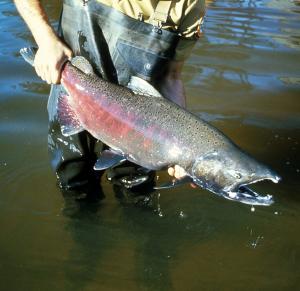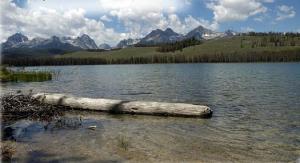forum
library
tutorial
contact

So Much Talk About So Few Fish
by Kim McDonaldCrosscut, April 15, 2008
|
the film forum library tutorial contact |

|
So Much Talk About So Few Fishby Kim McDonaldCrosscut, April 15, 2008 |
The salmon fisheries of the Northwest have spawned a new industry of bureaucrats, lawyers, environmentalists, sport fishers, commercial interests, scientists, and natives, all focused on the absence of fish. Meanwhile, four sockeye returned last summer to a lake in Idaho once teeming with tens of thousands.
 The players all know each other from years of meetings, retreats, conferences, lobbying, hearings, and more meetings. This is the state of salmon. While there may not be any fish, there are a lot of people talking about the fish.
The players all know each other from years of meetings, retreats, conferences, lobbying, hearings, and more meetings. This is the state of salmon. While there may not be any fish, there are a lot of people talking about the fish.
A friend on the Oregon Coast reports that commercial fishermen in Bandon, Ore., seem resigned to becoming caddies at a recently opened exclusive golf club. In an age where the talented dot.com generation easily slides from one occupation to another, it is hard to imagine the sorrow in selling a fishing boat that might have been your father's and grandfather's to the government to have money to pay the mortgage, feed the kids, and enroll in a community college for occupational re-training.
Since the endangered species listings for salmon in 1997, the Pacific Northwest has been awash in money spent on projects trying to protect salmon and steelhead habitat. The Bonneville Power Administration has spent millions and millions in either direct grants or through Washington state's Salmon Recovery Funding Board. One estimate suggests BPA spends about $400 per salmon that spawns up the Columbia River system. The funding sources and recipients of all this money are an eye-glazing list of acronyms and projects, including the small-boat launch adjacent to the Port of Seattle's Shilshole Marina.
In the meantime, this icon of the Pacific Northwest exists, really, in our memories and imaginations. It has vanished. The Chinook fishery "south of Falcon" (that is, south of Cape Falcon, which is near Astoria, Ore.) is completely closed, and the salmon fishery in Washington (north of Falcon) is severely restricted. There are, essentially, no fish.
Ironically, as the Pacific Fishery Management Council was meeting at a hotel in SeaTac, Wash., last week, four Pacific Northwest confederated tribes ( the Umatilla, Warm Springs, Yakama, and Colville) settled claims with BPA over the long litigation concerning operation of the Columbia and Snake River dams. The settlement was for $900 million, paid out over 10 years. The Nez Perce, critics of the operation of the Snake River dams, did not participate in the settlement and will continue with litigation, along with commercial fishermen and environmental organizations. From reports of the settlement, it appears $540 million will go toward salmon related projects and the rest for other fisheries. The tribes have shifted their priorities, pegging their hope on other fisheries, while the Nez Perce hold on, believing in a court-mandated solution to salmon recovery.
From all of this -- money, litigation, meetings, conferences, retreats, scientific reports -- the region has had little success in sustaining salmon spawns. The most powerful signs of failure are the four sockeye salmon that made the 900-mile swim from the mouth of the Columbia to Redfish Lake near Stanley, Idaho, in the summer of 2007. Old-timers in Stanley talk wistfully about how Redfish Lake (as in red sockeye) was, years ago, filled with red fish. Are salmon now a totem of our memories?
Instead of canneries and commercial fishing fleets dotting our coves and harbors, the new salmon industry is recovery of salmon. This new industry is in offices in Seattle, Portland, Boise, Olympia, Salem, Missoula, Helena, Sacramento, and San Francisco. There are nonprofits, governmental agencies, and tribal resource departments; departments within not only BPA but smaller, regional power agencies; and planners in transportation departments who address culverts and storm water drainage. Not to mention the grant writers who seek the money and the account managers to keep track of it all. Instead of checking nets, fixing diesel engines, and keeping an eye on the weather, the new salmon workers make sure their software works, that the GIS system has mapped every spawning stream, and that regulatory notices are published in a timely fashion.
In 1997, when the National Marine Fisheries Service (NMFS) announced the listings of numerous Evolutionary Significant Units (ESU) of salmon throughout the Pacific Northwest, regional leaders fell all over themselves to talk about self-arresting the losses. The slogan "extinction is not an option" finally went from T-Shirts and to the front pages of mainstream newspapers in the Northwest.
 But since 1997, there has also been enormous growth in the region, and political focus has shifted from salmon to homeland security to the economy. It seems as if this recent announcement of vast closures of salmon fisheries is met with a yawn, as if we expected this day would come.
But since 1997, there has also been enormous growth in the region, and political focus has shifted from salmon to homeland security to the economy. It seems as if this recent announcement of vast closures of salmon fisheries is met with a yawn, as if we expected this day would come.
Meanwhile, last summer, four Sockeye salmon swam up numerous fish ladders, through murky Columbia, Snake, and Salmon river water, avoided irrigation pumps, agricultural run-off, hydroelectric turbines, fishermen, terns, sea lions, and God-knows what other impediments. They swam into Redfish Lake, at 6,500 feet elevation in the middle of the Sawtooth Mountains. Whatever else is going on during the ongoing and never-ending meetings, conferences, and litigation over salmon, that moment, when those four Sockeye made it, is still a triumph and reason enough to not commit salmon to our memories but rather to our imaginations.
learn more on topics covered in the film
see the video
read the script
learn the songs
discussion forum
